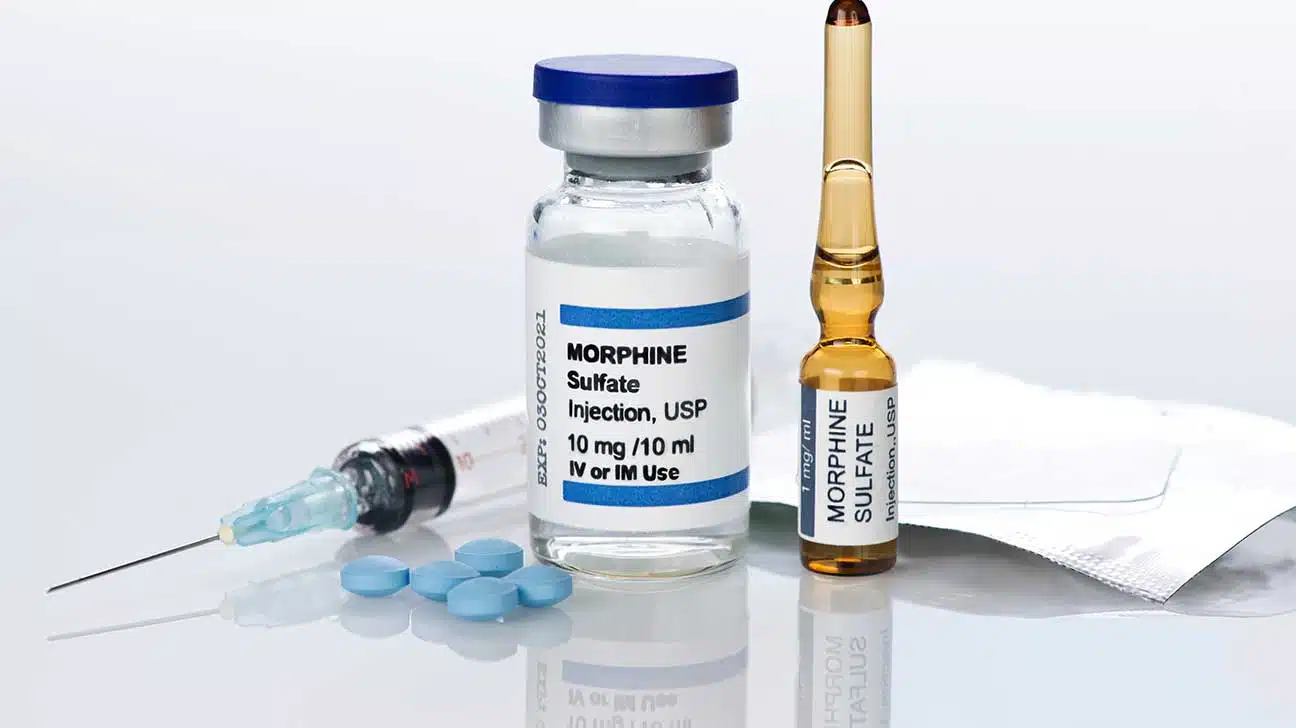
Morphine is a Schedule II opiate analgesic derived from the opium poppy. It is also known by the brand names Kadian, MS Contin, Avinza, and Oramorph.
The primary effects of morphine usually last between four and six hours. However, the window of effect may vary depending on the individual.
While how long the drug lasts is relatively narrow, the comedown from morphine can last several days if there is physical dependence.
How Long Does Morphine Affect The Brain And Body?
The initial effects of morphine on the brain and body typically last four to six hours, but this duration can vary depending on the individual, the form of morphine, and the method of abuse.
Like many synthetic opioids, the opiate morphine bonds with opioid receptors in the central nervous system (CNS) to inhibit pain signals.
While this interaction allows for the use of morphine as an effective painkiller, it also lays the groundwork for physical dependence by encouraging the brain to adapt to these changes.
Methods Of Morphine Abuse And How Long They Last
Morphine is distributed as tablets, extended-release capsules, and an injectable solution. These forms allow for different methods of drug abuse, each with a different duration of effect.
Oral Morphine Use
Morphine tablets and capsules can be taken orally. People who abuse morphine are more likely to consume a high dose of morphine.
The oral administration of morphine typically results in slower-acting, longer-lasting effects that can persist for up to six hours.
Intravenous Morphine Use
Morphine can also be administered intravenously. People who abuse morphine this way may do so because it creates a more immediate, intense, and short-lived high that lasts two to four hours.
Intravenous drug use does come with additional risks, especially when people use shared needles. Harm reduction programs can help by providing safe supplies.
How Long Does A Morphine Comedown Last?
The effects of the comedown from morphine usually last less than a day. If hangover-like symptoms persist, you may be experiencing withdrawal.
The euphoric feeling that is associated with a morphine high doesn’t last very long. For the majority of the drug’s effective time period, you will mostly experience intense sleepiness.
In addition to drowsiness, the effects of sedation may cause slower reaction times and difficulty concentrating.
As you come down from morphine, you may feel a bit groggy and off. If you have developed physical dependence, this comedown may also incorporate the first signs of withdrawal.
Morphine Addiction And The Duration Of Withdrawal
Opioid addiction is always a risk of using an opiate like morphine. While this risk can be minimized with responsible use, it is important to watch out for signs of increasing tolerance.
These signs are often the first indicator that your brain is adjusting to opioid use and could indicate the ongoing development of physical dependence.
People who use morphine should also report any signs of withdrawal to their healthcare provider. Common withdrawal symptoms include shaking, nausea, irritability, fatigue, and insomnia.
These symptoms typically last between five and seven days depending on the severity of the addiction.
While the goal is always to prevent addiction, you should know that treatment for morphine addiction and withdrawal is accessible through a number of accredited addiction treatment facilities.
Long-Term Health Consequences Of Morphine Abuse
People who are addicted to morphine should seek immediate addiction treatment. Opioid abuse is a high-risk addiction that contributes heavily to the rate of fatal overdose in the United States.
In addition to the risk of overdose, common side effects of morphine abuse include lasting mental health disorders and permanent organ damage.
Changes To Brain Chemistry
Drugs that interact with the central nervous system often cause changes in brain chemistry that prompt the brain to alter its normal behavior.
Morphine causes the release of dopamine in the brain, which causes the positive feelings associated with a morphine high. In the short term, that is what makes the drug effective.
However, long-term morphine use will cause the brain to produce lower levels of dopamine to balance the effects of the drug.
As a result, many people who are addicted to opioids struggle with anxiety and depression when they are not using.
Organ Damage
Drugs like morphine are processed by the kidneys and liver. Prolonged abuse of these medications can cause lasting damage to these major organs.
Permanent organ damage is usually the result of years of abuse, but damage can occur more quickly in concurrence with some health conditions.
Memory Loss
The connection between substance abuse and memory loss is not perfectly understood, but it is evident that multiple forms of substance abuse cause direct damage to the brain.
This damage can result in cognitive impairment, memory loss, and deficits in learning.
Morphine abuse is capable of causing all of these complications by disrupting the balance of excitatory and inhibitory synapses in the hippocampus.
Overdose Death
Opioid abuse is the most common cause of overdose in the United States. These fatal overdoses mostly result from respiratory depression, a condition characterized by slowed breathing.
Morphine abuse can certainly result in respiratory depression, but the risk is significantly higher with stronger synthetic opioids, like fentanyl.
Addiction Treatment Options For Morphine Abuse
Morphine addiction is a serious health condition with the potential for long-term and life-threatening consequences. Fortunately, there are a number of viable treatment options.
Medical Detox
Detoxification is a crucial step in addiction recovery. With opioid withdrawal, it is important to make sure that you receive proper support during this phase to ensure your safety and success.
Medical detox centers are staffed with qualified healthcare professionals who can supervise your progress and administer medications to treat the symptoms of morphine withdrawal.
Dual Diagnosis Treatment
Many people who are recovering from addiction need treatment for at least one additional mental health disorder.
Evidence-based addiction treatment programs often offer dual diagnosis treatment to address multiple, intertwining conditions, as they often reinforce one another.
Medication-Assisted Treatment (MAT)
Medication-assisted treatment is a viable treatment option for opioid addiction. This approach uses drugs like methadone to reduce the effects of withdrawal and eventually reduce dependence.
MAT is usually administered through a long-term program on an inpatient or outpatient basis depending on your preferences.
Outpatient Treatment
Outpatient addiction recovery services offer support to people who want to address their addiction without disrupting their everyday life.
People who need a more vigorous outpatient program may consider intensive outpatient programs (IOP), day treatment, or partial hospitalization programs (PHP).
Inpatient Treatment
Inpatient treatment can take place in a clinical or residential setting where participants are encouraged to solely focus on their recovery.
These treatment centers may be best suited to people with severe drug addiction and those who have relapsed after previous attempts.
FAQs Related To Morphine
Morphine is a vital tool that helps countless people deal with moderate to severe pain in hospitals throughout the U.S., but it’s important to recognize the risks that accompany the benefits.
To help you better understand morphine addiction, our team has listed some of the most frequently asked questions related to morphine.
Is Morphine An Opiate Or An Opioid?
While the terms are often used interchangeably, morphine is actually an opiate because it is naturally derived from the poppy plant.
Opioids are synthetic drugs that copy the natural behaviors of opiates. Both are considered narcotics.
How Strong Is Morphine Compared To Other Narcotics?
Morphine is a mid-tier narcotic that’s stronger than codeine and oxycodone. It’s a powerful drug, capable of handling severe chronic pain, but it is not nearly as strong as other drugs in its class.
For example, fentanyl is between 50 and 100 times stronger than morphine.
Can A Routine Blood Test Detect Morphine?
The half-life of morphine is relatively short, but morphine may be flagged on a routine blood test if you have used it within the past 24 hours.
Other drug screenings are more sensitive. A urine drug test can detect morphine metabolites up to four days after your last dose, and a hair sample has a detection window of up to 90 days.
What Can I Do To Reverse A Morphine Overdose?
A morphine overdose can be reversed by administering Narcan (naloxone). This drug is available through certain pharmacies and harm reduction programs to help address the opioid epidemic.
Naloxone is effective for reversing most opioid overdoses, but it may be less effective in treating an overdose caused by tramadol due to its formulation.
How Can I Convince My Loved One To Get Help For A Morphine Addiction?
When someone you love has a substance abuse disorder, it can be difficult for them to see how far the condition has progressed.
If your loved one is refusing treatment, contact an addiction recovery services program near you to discuss strategies, including an alcohol or drug intervention.
Find Substance Abuse Treatment Near You
Morphine addiction can be difficult to treat, especially when there are additional mental health disorders involved.
Fortunately, our team can help you find the addiction treatment plan that is best suited to your particular needs. If you’re ready to get help, then call us today.
Addiction Resource aims to provide only the most current, accurate information in regards to addiction and addiction treatment, which means we only reference the most credible sources available.
These include peer-reviewed journals, government entities and academic institutions, and leaders in addiction healthcare and advocacy. Learn more about how we safeguard our content by viewing our editorial policy.
- International Journal of Molecular Sciences
https://www.ncbi.nlm.nih.gov/pmc/articles/PMC5297852/ - Journal of Cell Biology
https://rupress.org/jcb/article/215/2/139/38748/How-morphine-tips-the-synaptic-balance - National Library of Medicine
https://medlineplus.gov/druginfo/meds/a682133.html


